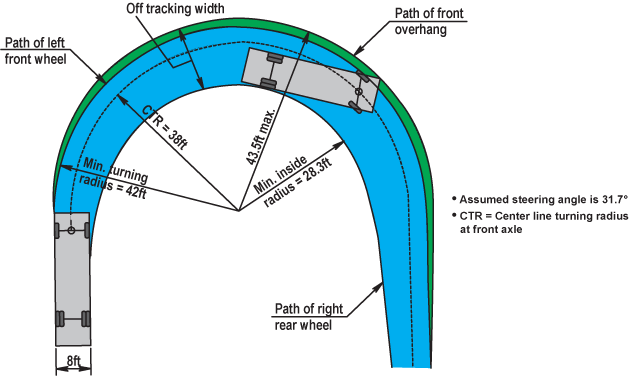Design Vehicle - Turning Characteristics

When designing an intersection, the largest design vehicle specified for that intersection should be able to negotiate the turn without climbing adjacent curbing and channelization islands. WB-67 is the most common semi-trailer. Commercial locations such as the BX, commissary, gas stations, or any other location that moves large quantity of goods should accommodate this truck. This would also include major roadways used to access these facilities.
Minimum Turning Radius
|
| Design Vehicle |
Passenger Car |
School Bus |
Single-Unit Truck |
Intermediate Semitrailer |
Interstate Semitrailer |
Interstate Semitrailer |
| AASHTO Symbol |
P |
S-BUS-40 |
SU-30 |
WB-50 |
WB-62 |
WB-67 |
| Minimum Inside Radius (Ft.) |
23.8 |
39.1 |
41.8 |
45 |
44.8 |
44.8 |
| Centerline Turning Radius (Ft.) |
21.0 |
35.4 |
47.4 |
41.0 |
41.0 |
41.0 |
| Minimum Design Turning Radius (Ft.) |
14.4 |
25.3 |
28.4 |
17.0 |
7.4 |
1.9 |
The chart above shows the minimum turning radius of common design vehicles. When designing intersections and other facilities that require tight movements by vehicles, these values must be considered for the appropriate design vehicle. The Design Vehicle Turning Movement portion of this module graphically depicts the turning movement paths for passenger car, school bus, single-unit truck, and interstate semitrailer design vehicles. The user can download these turning templates at the appropriate scale and overlay on drawings.


